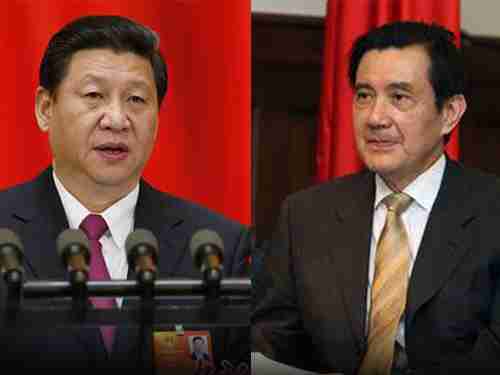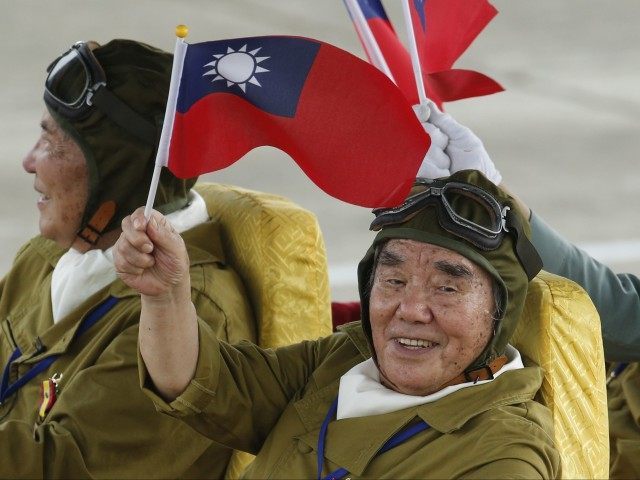This morning’s key headlines from GenerationalDynamics.com
- Presidents of China and Taiwan to meet in Singapore on Saturday
- China asserts a ‘bottom line’ to US in South China Sea
Presidents of China and Taiwan to meet in Singapore on Saturday

Xi Jinping (left) and Ma Ying-jeou
According to a surprise announcement on Tuesday, China’s President Xi Jinping and Taiwan’s President Ma Ying-jeou will meet and talk in Singapore on Saturday.
This will be the first time that leaders of China and Taiwan have met since Mao Zedong’s Communist Revolution, China’s massive civil war that climaxed in 1949, when Mao’s forced the Nationalist (KMT) forces, led by Chiang Kai-shek, to flee to Formosa (Taiwan), passing through Hong Kong, in 1949.
China has always considered Taiwan to be a province of China, but feelings on Taiwan hardened against China considerably in 1989, when Taiwan’s population watched in horror as China’s security forces brutally killed thousands of innocently protesting students in the Beijing’s Tiananmen Square massacre. This triggered a Taiwan student movement called “the Wild Lily rebellion,” and led to the creation of a new political party, Democratic Progressive Party (DPP), which explicitly favored independence.
DPP has been in power in Taiwan for about half of the last 15 years, and whenever they are in power, the Chinese Communist Party (CCP) in Beijing totally freaks out, issuing one threat after another, saying that it Taiwan makes even one tiny step in the direction of independence, then China will declare war.
However, the KMT have been in power in Taiwan since 2008, and relations between Taiwan and China have been relatively calm. The 2008 election was followed in China by the horrible Sichuan earthquake, which began a period of international good will directed at China, including a thaw in relations with Taiwan. Taiwan’s new president, Ma Ying-jeou, called for seizing “this historic opportunity to achieve peace and co-prosperity,” under the principle of “no unification, no independence and no use of force.” The two countries have followed an ambiguous 1992 agreement that said that there is only “one China,” but does not explain what that means. (See “Taiwan / China relations thaw in wake of election and earthquake” from 2008.)
The first signal that this calm in relations was about to end was KMT’s disastrous losses in local elections across Taiwan in November of last year. The election occurred just weeks after the start of the massive Hong Kong demonstrations, after China reneged on its promise that, at the time Hong Kong reverted to China in 1997, Hong Kong would have full, free elections. Many Taiwanese suddenly realized that their freedoms were similarly threatened, and that Beijing could never be trusted not to renege on any promise it made.
A presidential election is scheduled for January 16, and polls indicate that the DPP is going to return to power, and with it, a more pro-independence stance by the government. It is believed that Tuesday’s “thaw” in relations, announcing the meeting between Xi and Ma, is related to the January 16 election.
One possible purpose is to bolster KMT’s election fortunes. But that could just as easily backfire, as KMT’s opponents point to China’s interference in Taiwan’s election.
Another possibility is that the two will announce some major new China-Taiwan pro-unity initiative, and get it committed before DPP takes power in January. Or, perhaps, the purpose of the meeting is for Xi to make some kind of military threat. When Xi took office in 2013, he said that the situation with Taiwan could not go on much longer, with the implication that China was preparing to use military force to take control of Taiwan. So anything is possible. Focus Taiwan and AFP
China asserts a ‘bottom line’ to US in South China Sea
At a meeting of Southeast Asia defense ministers in the Association of South East Asian Nations (ASEAN), both the US and China asserted their positions with regard to the South China Sea.
More than half the world’s merchant tonnage passes through the South China Sea, and China would be able to harass or target any country’s commercial shipping. China has been annexing regions in the South China Sea that have historically belonged to other countries, and continues and uses belligerent military operations to enforce its seizures. China has claimed the entire South China Sea, including regions historically belonging to Vietnam, Brunei, Malaysia, Indonesia, Taiwan and the Philippines. China’s claims are rejected by almost everyone outside of China, and China refuses to submit them to the United Nations court deciding such matters, apparently knowing that they would lose.
China has used land reclamation projects to build a chain of man-made islands in international waters around the Spratly Islands, and apparently plans to use them as military naval bases. Recently, the US challenged China by sending a surveillance ship to within 12 miles of China’s man-made islands, triggering a furious response from China’s Ministry of Defense.
At the ASEAN on Tuesday, Secretary of Defense Ash Carter is quoted as reiterating previous statements that “the United States will fly, sail, and operate wherever international law allows, as we do all around the world.”
China’s defense minister Chang Wanquan was quoted as saying:
But that said, we need to do things that help us defend our sovereign territory and I need to be very clear to you that there is a bottom line to this.
It is not “very clear” what the “bottom line” is, but China has repeatedly threatened to take military retaliation for future US surveillance activities. Reuters
KEYS: Generational Dynamics, China, Taiwan, Xi Jinping, Ma Ying-jeou, Mao Zedong, KMT, Kuomintang, DPP, Democratic Progressive Party, Chiang Kai-shek, Tiananmen Square massacre, Wild Lily Rebellion, Association of South East Asian Nations, ASEAN, South China Sea, Ash Carter, Chang Wanquan
Permanent web link to this article
Receive daily World View columns by e-mail

COMMENTS
Please let us know if you're having issues with commenting.